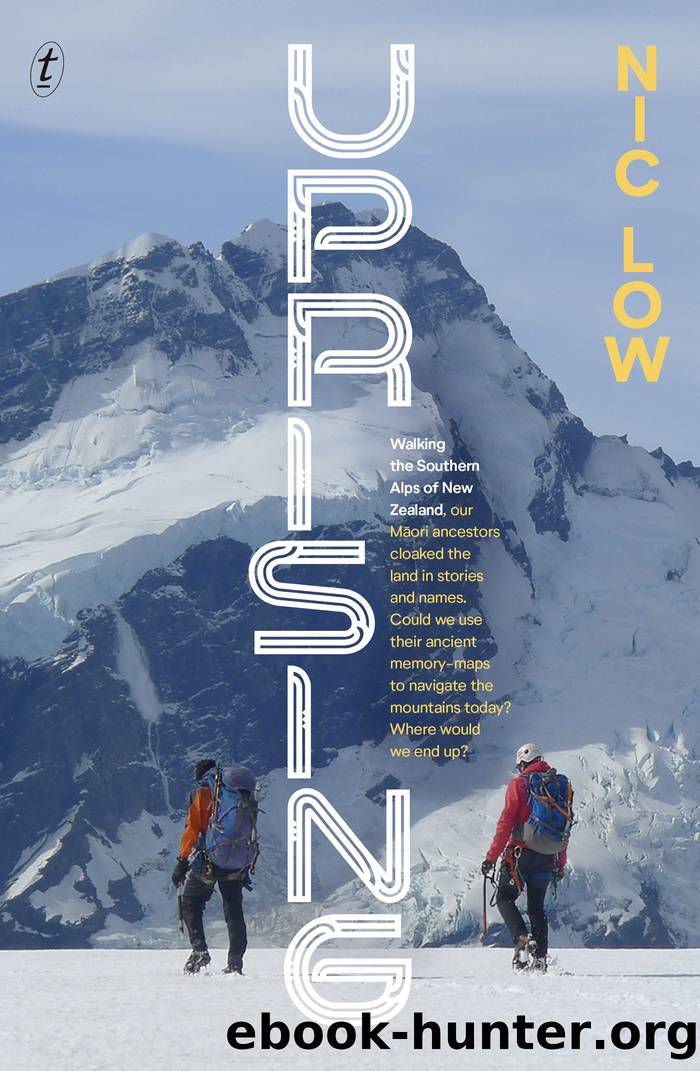Uprising: Walking the Southern Alps of New Zealand by Low Nic

Author:Low, Nic
Language: eng
Format: epub
Publisher: The Text Publishing Company
Published: 2021-06-02T00:00:00+00:00
PART II: AROAROKAEHE RANGE, CANTERBURY ALPS. LATE AUTUMN.
The landscape all around us was sacred and storied for NgÄi Tahu, and the key to unlocking it lay in whakapapa. The three rÅ«naka (councils) who hold mana whenua (authority and guardianship over the land) in this area on the eastern side, Moeraki, Waihao and Arowhenua, have a genealogy describing much of this view. It shows lines of descent from Aoraki and his brothers to the other major mountains in the area, south to the sacred lakes PÅ«kaki and TakapÅ, to the ancestor mountains in Te Manahuna (the Mackenzie Basin), down the generations to the Waitaki Valley to Korotuaheka, an ancient village on the east coast.
The chant links NgÄi Tahu to the landscape through genealogy, and is another oral map listing the key landmarks needed to navigate between high country and coast. Like all whakapapa, itâs also a compendium of history: you could write a book about the story behind each line.
Take âKi te taha wahine a Aroarokaeheâ (And to the female side and the Hooker Valley). Aroarokaehe, the mountain range weâd just climbed, was a crew member of the Araiteuru waka, which reached New Zealand only to run aground on a reef at Matakaea (Shag Point), off the far-south ÅtÄkou coast. She and the other crew swam ashore, then went exploring inland. They had to be back at the canoe by daylight. But some were still out at dawn, and when the sun struck them they turned to stone, and are now important landmarks spread across Te Waipounamu (including the Christchurch Cathedral). Aroarokaehe became a mountain in the foothills twenty kilometres south of here, until Kirikirikatata (Mt Cook Range) convinced her to leave her lowly station and move up into the high Alps at his side. In this tradition, Kirikirikatata carries his grandson, Aoraki, on his shoulders: the highest mountain is a child, supported by the generations who came before.
You sometimes hear the idea that Araiteuru is a mythical waka, and that when people said âour tÄ«puna came here on the Araiteuruâ, they were talking in vague, mystical terms. But Araiteuru was the waka (conveyance) by which people arrived here: itâs the name of a navigational star path used by early Polynesian voyagers to reach Aotearoa. A star path is the memorised sequence of stars that rise or set throughout the night at the point on the horizon where you wish to go. When the first arrivals made landfall, they went exploring, and gave those navigational starsâ names to the mountains of their new home, including Aroarokaehe. Recalling the stars as people who crossed the sea, then became mountains when the sun rose (stars not being much use by day), is a damn good way of ensuring that the celestial knowledge was passed on.
All of these ideas unfold from a single line in the chant. And while the chant takes the form of whakapapa, this is not just a metaphorical device. We descend from these mountains because life begins here. As David
Download
This site does not store any files on its server. We only index and link to content provided by other sites. Please contact the content providers to delete copyright contents if any and email us, we'll remove relevant links or contents immediately.
Spare by Prince Harry The Duke of Sussex(5132)
Machine Learning at Scale with H2O by Gregory Keys | David Whiting(4256)
Fairy Tale by Stephen King(3305)
Will by Will Smith(2871)
Hooked: A Dark, Contemporary Romance (Never After Series) by Emily McIntire(2527)
The Bullet Journal Method by Ryder Carroll(2524)
Rationality by Steven Pinker(2325)
Can't Hurt Me: Master Your Mind and Defy the Odds - Clean Edition by David Goggins(2267)
It Starts With Us (It Ends with Us #2) by Colleen Hoover(2251)
Friends, Lovers, and the Big Terrible Thing by Matthew Perry(2177)
The Becoming by Nora Roberts(2147)
Love on the Brain by Ali Hazelwood(2015)
HBR's 10 Must Reads 2022 by Harvard Business Review(1819)
The Strength In Our Scars by Bianca Sparacino(1816)
A Short History of War by Jeremy Black(1815)
Leviathan Falls (The Expanse Book 9) by James S. A. Corey(1693)
A Game of Thrones (The Illustrated Edition) by George R. R. Martin(1657)
515945210 by Unknown(1640)
Bewilderment by Richard Powers(1574)
